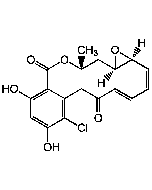Cookie Policy: This site uses cookies to improve your experience. You can find out more about our use of cookies in our Privacy Policy. By continuing to browse this site you agree to our use of cookies.
AdipoGen Life Sciences
Dichloroacetate [DCA] . sodium salt
As low as
55
CHF
CHF 55.00
In stock
Only %1 left
AG-CR1-3684-G0011 gCHF 55.00

| Product Details | |
|---|---|
| Synonyms | Dichloroacetic acid sodium salt; Bichloroacetic acid; BCA |
| Product Type | Chemical |
| Properties | |
| Formula |
C2HCl2O2 . Na |
| MW | 127.9 . 23.0 |
| CAS | 2156-56-1 |
| Purity Chemicals | ≥98% |
| Appearance | White to off-white solid. |
| Solubility | Soluble in water (10mg/ml) or DMSO (10mg/ml). |
| InChi Key | LUPNKHXLFSSUGS-UHFFFAOYSA-M |
| Smiles | ClC(Cl)C([O-])=O.[Na+] |
| Shipping and Handling | |
| Shipping | AMBIENT |
| Short Term Storage | +20°C |
| Long Term Storage | +4°C |
| Handling Advice | Keep cool and dry. |
| Use/Stability | Stable for at least 2 years after receipt when stored at +4°C. |
| Documents | |
| MSDS |
 Download PDF Download PDF |
| Product Specification Sheet | |
| Datasheet |
 Download PDF Download PDF |
Description
- Mitochondrial pyruvate dehydrogenase kinase (PDK) inhibitor, consequently activating pyruvate dehydrogenase (PDH).
- Decreases glycolysis. Shifts pyruvate metabolism from glycolysis and lactate production to glucose oxidation in the mitochondria.
- Antitumor agent. Decreases tumor growth in vitro and in vivo. Induces mitochondrial-dependent apoptosis.
- Useful agent for immunometabolism research.
- Glucose entering the cell is metabolized by glycolysis to pyruvate. Most of the pyruvate in non-cancerous cells enters the mitochondria under aerobic conditions and a small fraction is metabolized to lactate. PDH in mitochondria converts pyruvate into acetyl-CoA, which enters the TCA cycle. In cancer cells, the oxidative (mitochondrial) pathway of glucose utilization is suppressed and most of the pyruvate is converted into lactate (Warburg effect). The relative activities of LDH and PDH therefore determine the fate of pyruvate. PDK inhibits PDH through phosphorylation and regulates its activities, resulting in suppression of the TCA cycle and mitochondrial respiration. This renders PDK a promising target for the treatment of various cancers.
Product References
- Activation of pyruvate dehydrogenase in perfused rat heart by dichloroacetate: S. Whitehouse & P.J. Randle; Biochem. J. 134, 651 (1973)
- The pharmacology of dichloroacetate: P.W. Stacpoole; Metabolism 38, 1124 (1989)
- A mitochondria-K+ channel axis is suppressed in cancer and its normalization promotes apoptosis and inhibits cancer growth: S. Bonnet, et al.; Cancer Cell 11, 37 (2007)
- Distinct Structural Mechanisms for Inhibition of Pyruvate Dehydrogenase Kinase Isoforms by AZD7545, Dichloroacetate, and Radicicol: M. Kato, et al.; Cell Structure 15, 992 (2007)
- Metabolic Modulation of Glioblastoma with Dichloroacetate: E.D. Michelakis, et al.; Sci. Transl. Med. 2, 31 (2010)
- PDK1 inhibition is a novel therapeutic target in multiple myeloma: S. Fujiwara, et al.; Br. J. Cancer 108, 170 (2013)1
- A guide to immunometabolism for immunologists: L.A. O'Neill, et al.; Nat. Rev. Immunol. 16, 553 (2016)
- The pyruvate dehydrogenase complex in cancer: An old metabolic gatekeeper regulated by new pathways and pharmacological agents: E. Saunier, et al.; Int. J. Cancer 138, 809 (2016) (Review)
- The PDK1 Inhibitor Dichloroacetate Controls Cholesterol Homeostasis Through the ERK5/MEF2 Pathway: A.U. Haq Khan, et al.; Nat. Sci. Rep. 7, 10654 (2017)
- Dichloroacetate induces regulatory T-cell differentiation and suppresses Th17-cell differentiation by pyruvate dehydrogenase kinase-independent mechanism: N. Makita, et al.; J. Pharm. Pharmacol. 69, 43 (2017)








